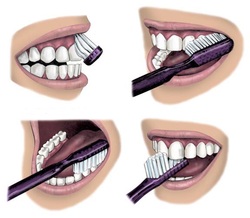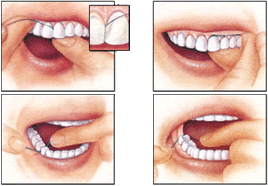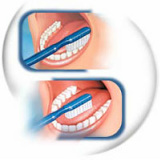Oral Health Care and Prevention
Schedule Appointments!
Typically patients who are registered at Smiles Inc see the Dental Hygienist once every six months for their regular hygiene visits, the dentist once a year for an examination, and have radiographs taken every two years. If you have any issues in between your scheduled visits then please call us, or if the hygienist sees anything unusual she will inform the Doctor. Some people need to be seen more frequently than others, but this would be on an individual basis.
This schedule for your appointments, ensures that everyone is well taken care of without using resources unnecessarily. This is why it is important to keep to your scheduled appointment times.
This schedule for your appointments, ensures that everyone is well taken care of without using resources unnecessarily. This is why it is important to keep to your scheduled appointment times.
Prevention

The Preventive ProgramBoth natural teeth and teeth with restorations survive best in an oral environment that is clean and where the intake of harmful foods is controlled. Our program is designed to help prevent new cavities, preserve teeth that have been restored and manage periodontal disease. At the initial visit oral hygiene instructions are reviewed and are reinforced at subsequent recall visits. The following are helpful recommendations:
- Brush your teeth twice a day in a circular motion with a soft bristled toothbrush aimed at the gum.
- Floss every night in an up and down motion while keeping the floss in a U-shape and against the tooth surface.
- Avoid smoking
- Avoid sticky sugary foods.
- Eat a balanced diet.
- Use antiseptic and fluoride rinses as directed.
- Sealants placed on young permanent teeth
Proper Brushing Technique

Proper brushing is essential for cleaning teeth and gums effectively. Use a toothbrush with soft, nylon, round-ended bristles that will not scratch and irritate teeth or damage gums.
Place bristles along the gumline at a 45-degree angle. Bristles should contact both the tooth surface and the gumline.
Gently brush the outer tooth surfaces of 2-3 teeth using a vibrating back & forth rolling motion. Move brush to the next group of 2-3 teeth and repeat.
Maintain a 45-degree angle with bristles contacting the tooth surface and gumline. Gently brush using back, forth, and rolling motion along all of the inner tooth surfaces.
Tilt brush vertically behind the front teeth. Make several up & down strokes using the front half of the brush.
Place the brush against the biting surface of the teeth & use a gentle back & forth scrubbing motion. Brush the tongue from back to front to remove odor-producing bacteria.
Remember to replace your toothbrush every three to four months. Researchers have established that thousands of microbes grow on toothbrush bristles and handles. Most are harmless, but others can cause cold and flu viruses, the herpes virus that causes cold sores, and bacteria that can cause periodontal infections.
Source: American Dental Hygienist’s Association
Place bristles along the gumline at a 45-degree angle. Bristles should contact both the tooth surface and the gumline.
Gently brush the outer tooth surfaces of 2-3 teeth using a vibrating back & forth rolling motion. Move brush to the next group of 2-3 teeth and repeat.
Maintain a 45-degree angle with bristles contacting the tooth surface and gumline. Gently brush using back, forth, and rolling motion along all of the inner tooth surfaces.
Tilt brush vertically behind the front teeth. Make several up & down strokes using the front half of the brush.
Place the brush against the biting surface of the teeth & use a gentle back & forth scrubbing motion. Brush the tongue from back to front to remove odor-producing bacteria.
Remember to replace your toothbrush every three to four months. Researchers have established that thousands of microbes grow on toothbrush bristles and handles. Most are harmless, but others can cause cold and flu viruses, the herpes virus that causes cold sores, and bacteria that can cause periodontal infections.
Source: American Dental Hygienist’s Association
Proper Flossing Technique

Flossing is an essential part of the tooth-cleaning process because it removes plaque from between teeth and at the gumline, where periodontal disease often begins.
If you find using floss awkward or difficult, ask your dental hygienist about the variety of dental floss holders or interdental cleaning devices that are available.
Wind 18" of floss around middle fingers of each hand. Pinch floss between thumbs and index fingers, leaving a 1"- 2" length in between. Use thumbs to direct floss between upper teeth.
Keep a 1" - 2" length of floss taut between fingers. Use index fingers to guide floss between contacts of the lower teeth.
Gently guide floss between the teeth by using a zig-zag motion. DO NOT SNAP FLOSS BETWEEN YOUR TEETH. Contour floss around the side of the tooth.
Slide floss up and down against the tooth surface and under the gumline. Floss each tooth thoroughly with a clean section of floss.
If you find using floss awkward or difficult, ask your dental hygienist about the variety of dental floss holders or interdental cleaning devices that are available.
Wind 18" of floss around middle fingers of each hand. Pinch floss between thumbs and index fingers, leaving a 1"- 2" length in between. Use thumbs to direct floss between upper teeth.
Keep a 1" - 2" length of floss taut between fingers. Use index fingers to guide floss between contacts of the lower teeth.
Gently guide floss between the teeth by using a zig-zag motion. DO NOT SNAP FLOSS BETWEEN YOUR TEETH. Contour floss around the side of the tooth.
Slide floss up and down against the tooth surface and under the gumline. Floss each tooth thoroughly with a clean section of floss.
Treatment of Bad Breath

It is important to conduct thorough oral hygiene at home twice daily utilizing tooth brushing with a fluoride antibacterial toothpaste and flossing to remove food debris and plaque on teeth, bridgework and implants, and brushing the tongue to remove odor-causing bacteria.
Tongue Cleaning is the Key to Fresher, Cleaner breath. Cleaning your tongue is very important. You can purchase a toothbrush with the tongue cleaner on the back of the toothbrush for cleaning both your teeth and tongue. After tooth brushing your upper and lower teeth with an antibacterial toothpaste, flip the toothbrush over to the tongue cleaner and place the tongue cleaner in the posterior region of the tongue and move it forward to the anterior section of the tongue. After you have scraped that portion of the tongue, rinse the tongue brush off with warm water to remove any odor causing bacteria. Then replace the tongue brush in the next posterior section again and repeat as described above again.
Consult your dentist or dental hygienist when choosing oral hygiene aids to help you eliminate plaque and odor causing bacteria and review the techniques that should be utilized at home. Also, ask your dental professional what oral hygiene care products they would consider you use to help eliminate bad breath (antibacterial toothpaste, antiseptic mouth rinse, tongue brushes or scrapers and interproximal cleaning devices).
The key to a clean, fresh mouth is optimal oral hygiene conducted at home on a regular basis and professional recommendations discussed with you by your dental professional.
Tongue Cleaning is the Key to Fresher, Cleaner breath. Cleaning your tongue is very important. You can purchase a toothbrush with the tongue cleaner on the back of the toothbrush for cleaning both your teeth and tongue. After tooth brushing your upper and lower teeth with an antibacterial toothpaste, flip the toothbrush over to the tongue cleaner and place the tongue cleaner in the posterior region of the tongue and move it forward to the anterior section of the tongue. After you have scraped that portion of the tongue, rinse the tongue brush off with warm water to remove any odor causing bacteria. Then replace the tongue brush in the next posterior section again and repeat as described above again.
Consult your dentist or dental hygienist when choosing oral hygiene aids to help you eliminate plaque and odor causing bacteria and review the techniques that should be utilized at home. Also, ask your dental professional what oral hygiene care products they would consider you use to help eliminate bad breath (antibacterial toothpaste, antiseptic mouth rinse, tongue brushes or scrapers and interproximal cleaning devices).
The key to a clean, fresh mouth is optimal oral hygiene conducted at home on a regular basis and professional recommendations discussed with you by your dental professional.
